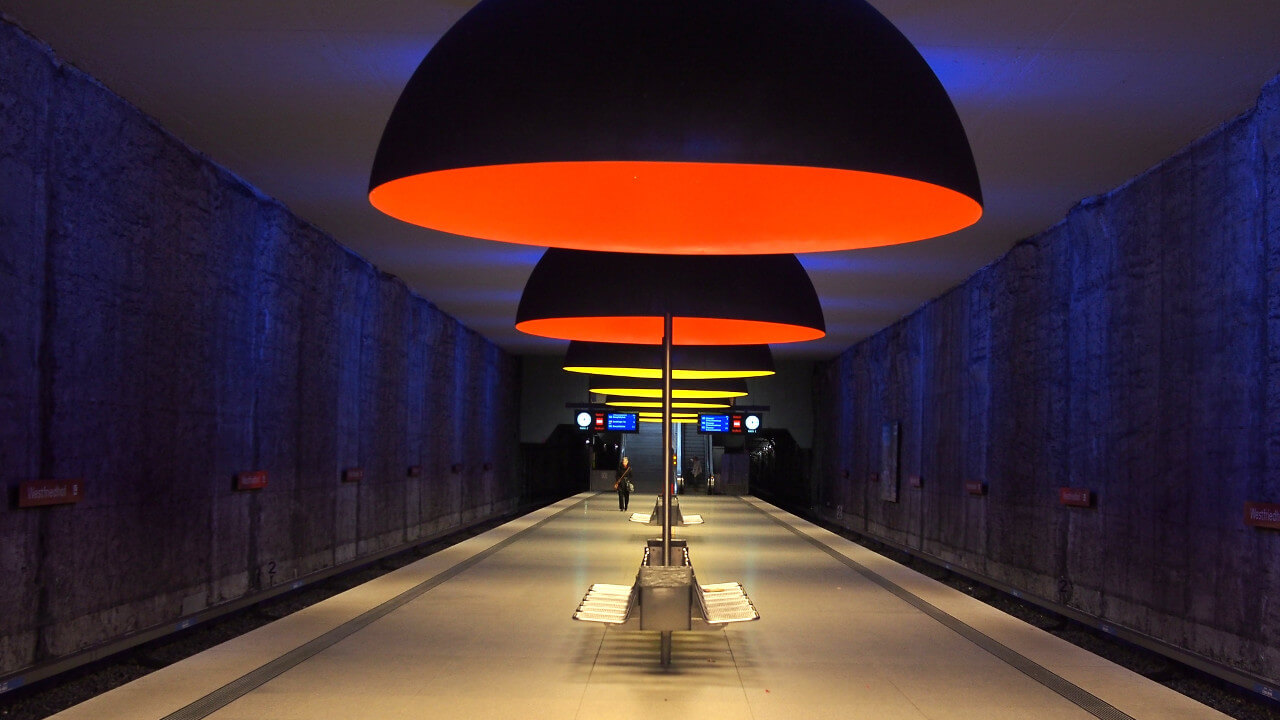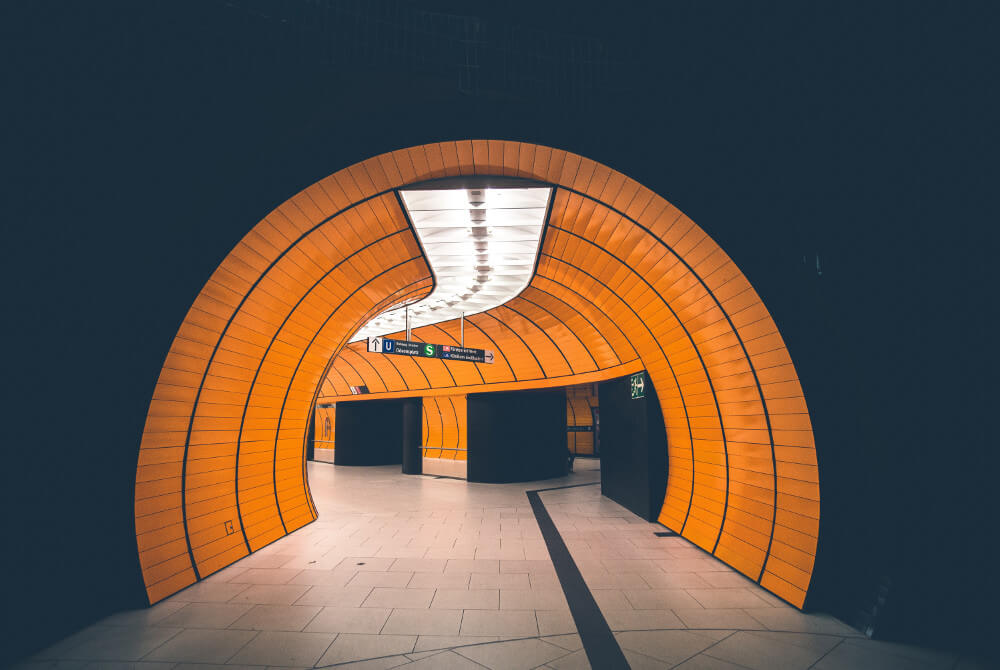Munich metro map – The subway network
The subway network in Munich was built in preparation for the 1972 Summer Olympics and is therefore much younger than the subway network in Berlin, which has existed since 1902. The eight operating lines wind their way through the Bavarian capital over a total length of 103.1 kilometers and currently serve 100 stations throughout the city. The subway lines operated by Münchner Verkehrsgesellschaft (MVG) can be recognized on Munich’s public transport map by the large “U” in front of them.
A special feature of the Munich subway is the three main lines through the city center, each of which is covered by two lines. The resulting overlaps are defined in the Munich subway plan so that there is a dense and even train sequence on these heavily frequented routes. The subway plan in Munich also provides for two booster lines, the U7 and U8. While the U7 between 7 and 9 a.m. and 3 and 7 p.m. serves to absorb the peaks in school traffic, the U8 is intended to relieve traffic on Saturdays.
The Munich subway lines at a glance
- U1 (Olympia shopping center – Mangfallplatz)
- U2 (Feldmoching – Messestadt Ost)
- U3 (Moosach – Fürstenried West)
- U4 (Westendstraße – Arabellapark)
- U5 (Laimer Platz – Neuperlach South)
- U6 (Garching-Forschungszentrum – Klinikum Großhadern)
- U7 (Olympia shopping center – Neuperlach center)
- U8 (Olympiazentrum – Sendlinger Tor)
Information for tourists about the subway map in Munich
By the time it hosted the 1972 Summer Olympics, Munich had developed from a sleepy provincial town into a cosmopolitan city. This development is also reflected in the number of subway passengers. In 2015 alone, MVG’s subway trains carried 398 million passengers – and the trend is rising. In addition to numerous schoolchildren and commuters, there are also more and more tourists from Germany and abroad on the trains.
Current publications from the city of Munich speak of around 14 million visitors in 2016. Since many sights such as the Allianz Arena, the Frauenkirche, Nymphenburg Palace and the Olympic Park are best reached by subway, it is very important to know the ticket prices and timetables, especially when on vacation in Munich.
Munich subway tickets & prices
As in many other major cities, Munich relies on a standardized ticket system. The tickets of the Munich Transport and Tariff Association are thus valid for the subway as well as for the bus, streetcar and S-Bahn. The price of a subway ticket in Munich is generally based on fixed fare zones. There are four of them in the Bavarian capital, marked with different colors. While the white zone exclusively covers the city center starting from Karlsplatz, the green, yellow and red zones each cover more remote parts of the city, such as the airport in the north.
If you want to buy a subway ticket in Munich, you should take a look at the fare zones beforehand, as tickets can be purchased for just one zone or for up to four zones. The more zones the desired ticket covers, the more expensive it becomes.
Alternatively, MVV also offers inexpensive short-distance tickets that are valid for a maximum of four stops. In Munich, tickets are also subject to a maximum travel time. While a short-distance ticket is valid for one hour, for example, a “full” ticket that covers an entire zone remains valid for three hours. From two zones, the maximum travel time increases to four hours.
In addition to one-way tickets, day tickets for singles and groups as well as particularly inexpensive children’s day tickets are also available. There are also multi-day tickets for three or four days and the CityTourCard. This special multi-day ticket is particularly interesting for tourists who are planning a longer stay in Munich. In addition to entitlement to subway travel in the selected period and fare zone, the CityTourCard also includes substantial discounts at over 70 tourist attractions in Munich and the surrounding area. However, day and multi-day tickets are valid until 6 a.m. on the following day.
The most important subway tickets in Munich
| Ticket | Prices | Buy a ticket |
|---|---|---|
| Single ride | from 2.80 Euro | View ticket |
| Single ride (childs 6-14) | from 1.40 Euro | View ticket |
| Daily ticket | from 6.60 Euro | View ticket |
| Daily group ticket | from 12.60 Euro | View ticket |
| Daily child ticket | from 3.10 Euro | View ticket |
| CityTourCard | from 11.90 Euro | View ticket |
| Air-Port-City-Day-Ticket | from 12.80 Euro | View ticket |
| Multi day tickets | from 16.50 Euro | View ticket |
In Munich, U-Bahn tickets are generally available from ticket machines at U-Bahn and S-Bahn stops as well as from machines inside buses and streetcars. In addition, some tickets can also be purchased in the form of online and cell phone tickets. The latter is particularly easy with the help of the MVV app. However, the MVV cell phone ticket is only valid in conjunction with a photo ID.
The same rule applies to print tickets, which can be printed out at home in advance. In Munich, tickets purchased from ticket machines must also be validated. The ticket validators provided for this purpose are usually located at the entrance to the platforms and are easily recognizable by their blue color. An exception to this are subway tickets from Deutsche Bahn vending machines. Tickets can be optionally validated there.
Subway timetable in Munich
The subway schedule in Munich is designed to run every 5 minutes, especially at peak times, to ensure a smooth commute. Outside rush hours, all lines in Munich run every 10 minutes according to the subway timetable. While the subway trains run continuously in many major cities, the subway plan in Munich does not provide for continuous night-time operation with the exception of the night between New Year’s Eve and New Year’s Day. As a result, trains are at a standstill between 1 a.m. and 4 a.m. during the week. On the nights from Friday to Saturday and Saturday to Sunday, however, the subway runs until 2 am. In both the first and last hours of operation, most lines only run every 20 to 30 minutes.
To the timetables of the Munich subway lines:
U1, U2, U3, U4, U5, U6, U7, U8
Just because the subway plan in Munich does not provide for such connections does not mean that night owls have to walk. Replacement services during the week between 1.30 a.m. and 4.30 a.m. are provided by night buses (N40-N45) and the night streetcar lines (N16, N19, N20, N27). At weekends and on the nights before public holidays, the above-mentioned bus connections, which are supplemented by the night buses N72-N79 and N80-N81, even run every half hour.
Further information on the Munich subway
Inspired by the construction of subway railroads in other major cities such as Berlin (1902), plans for the construction of a subway railroad were also developed in Munich at the turn of the century. This plan envisaged an underground route between the main station and Ostbahnhof, but was rejected as the expense would not have been worth it for the volume of traffic. As two further subway projects failed in 1929 (Great Depression) and 1941 (Second World War), it would take until 1965 for the ground-breaking ceremony for today’s subway to take place.





